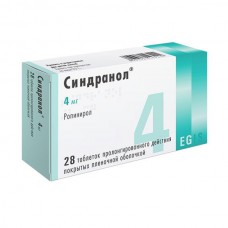Expiration date: 04/2025
Composition for 1 tablet:
Active substance: ropinirole hydrochloride 2,28/4,56/9,121 mg, which corresponds to 2/4/8 of ropinirole mg.
Excipients: methyl methacrylate, trimetilammoniietilakrilata chloride and copolymer etilakrilata [2:0.1:1] 5,28/10,56/21,12 mg; hypromellose 89,955/179,91/359,819 mg; sodium lauryl 6,75/13,5/27 mg; copovidone 44,64/89,28/178,56 mg; magnesium stearate 1,095/2,19/4,38 mg.
Shell: Opadry II pink 32K14834 (4.5 mg)/Opadry yellowish brown
Oh-27207 (9 mg)/Opadry red 03B25227 (18 mg).
Opadry II pink 32K14834: lactose monohydrate 40 % (1.8 mg); hypromellose-2910 (hypromellose-15??) 28 % (1,26 mg); titanium dioxide 23,46 % (1,0557 mg); triacetin 8 % (at 0.36 mg); dye iron oxide red 0,54 % (0,0243 mg).
Opadry yellowish-brown OU-27207: hypromellose-2910 (hypromellose-6cP) 62,5 % (5,625 mg); titanium dioxide and 21.25 % (1,9125 mg); the dye sunset yellow aluminium lacquer (FD&C yellow #6) (E110) 9 % (0,81 mg); macrogol-400 6,25 % (0,5625 mg) Indigo Carmine aluminium varnish (FD&C blue #2) (E132) 1 % (0.09 mg).
Opadry red 03B25227: hypromellose-2910 (hypromellose-6cP) 62,5 % (11,25 mg); titanium dioxide of 24.19 % (4,3542 mg); macrogol-400 6,25 % (1,125 mg), colouring agent iron oxide red of 6.14 % (1,105 mg); the colorant iron oxide black of 0.89 % (0,1602 mg); dye iron oxide yellow 0,03 % (0,0054 mg).
Tablets 2 mg: Round, biconvex tablets, film-coated pink. In cross section the core is almost white.
Tablets 4 mg: Oblong, biconvex tablets, film-coated light-brown color. In cross section the core is almost white.
Pharmacodynamics
Mechanism of action
Ropinirole is an effective and pergolino highly selective agonist of D2-, D3-dopamine receptor, which has peripheral and Central effects.
The drug has no effect on the collapsing of the presynaptic dopaminergic neurons of the black substance and acts directly as a synthetic neurotransmitter.
Thus, ropinirole reduces the degree of inactivity, rigidity and tremor, which are symptoms of Parkinson's disease.
Ropinirole make up for the deficiency of dopamine in the system matter and black striped body by stimulating dopamine receptors in the striatum.
Ropinirole has an effect on the level of the hypothalamus and pituitary, inhibiting the secretion of prolactin.
Ropinirole enhances the effects of levodopa, including control of the frequency of the phenomenon of "on/off" effect and "end of dose" associated with prolonged administration of levodopa.
The impact of ropinirole on the repolarization of the myocardium
The impact of ropinirole on the duration of the QT interval was studied in healthy volunteers (men and women) receiving ropinirole tablets immediate release at doses of 0.5, 1,2 and 4 mg once a day. The maximum elongation of the QT interval when taking ropinirole at a dose of 1 mg was 3.46 MS compared with placebo. The upper limit of the unilateral 95% confidence interval (CI) for the highest average effect was less than 7.5 milliseconds. The impact of ropinirole on the duration of the QT interval when taking higher doses has not been studied.
There is no risk of QT interval prolongation on the ECG when using ropinirole in doses up to 4 mg/day. To completely eliminate the risk of QT interval prolongation on the ECG in the application of ropinirole is impossible, since there is no analysis of the data for its use in doses up to 24 mg/day.
Pharmacokinetics
Suction
The bioavailability of ropinirole after oral administration is approximately 50% (36%-57%). After oral administration of ropinirole tablets of the prolonged action its concentration in blood plasma increases slowly. The average time to reach maximum drug concentration in plasma (Dmah) is 6-10 hours. At steady state in patients with Parkinson's disease after intake of 12 mg of ropinirole once a day simultaneously with fatty foods, in comparison with the use of fasting observed increase in systemic exposure of ropinirole. It was noted the increase in the area under the curve "concentration-time" (AUC) (90% CI [1,12; 1,28] and maximum concentration of drug in plasma (Cmax) (90% CI [1,34; 1,56]) on average by 20% and 44%, respectively, while Dmah lengthened to 3 h. Systemic exposure of ropinirole when receiving the tablets of the prolonged action corresponds to systemic exposure when the pill immediate release the same daily dose.
Distribution
Relationship with blood plasma proteins is low and accounts for 10-40%. Due to its high lipophilicity ropinirole is characterized by a large volume of distribution (Vd) (about 7 l/kg).
Biotransformation
Ropinirole is actively metabolized in the liver primarily by CYP1A2 isoenzyme. The main metabolite (N-dipropyl) is inactive and is converted in the future to carbonylcyanide, carboxylic acids and N-despropyl of gidroximetabolitov. Metabolites predominantly excreted by the kidneys.
Excretion
The elimination half-life (T?) of ropinirole from systemic blood flow an average of about 6 h. the increase in the duration of systemic action of ropinirole (AUC and Cmax) is approximately proportional to the dose increase. No differences in the excretion of ropinirole after single oral doses in or with regular use.
Noted high interindividual variability in pharmacokinetics. When using ropinirole tablets prolonged action in the equilibrium state, interindividual variability of Cmax amounted to 30-55%, AUC 40-70%.
Linenot/nonlinearity
The pharmacokinetics of ropinirole at a dose of 24 mg/day linear (tablets of ropinirole immediate release 8 mg 3 times a day).
Pharmacokinetics in specific groups of patients
Violation of kidney function
The pharmacokinetic parameters are not changed in patients with Parkinson's disease with impaired renal function mild to moderate.
In patients with end-stage renal failure in software (chronic) hemodialysis, clearance of ropinirole when administered is reduced by about 30%. The ground clearance of the metabolite of ropinirole is also reduced by approximately 60-80%. Therefore, the maximum daily dose in these cases is 18 mg.
Elderly patients
The clearance of ropinirole after oral decreases by approximately 15% in patients aged 65 years and older, compared with younger patients. Dose adjustment in this category of patients is not required.
Indications for use
Parkinson's Disease:
- monotherapy early stages of the disease in patients requiring dopaminergic therapy to delay the prescribing of levodopa.
- as a combination therapy in patients receiving levodopa, to enhance the effectiveness of levodopa, including fluctuations of the therapeutic effect of levodopa (the phenomenon of "on-off") and the effect of "end of dose" on the background of chronic levodopa therapy, and to reduce the daily dose of levodopa.
Contraindications
- Hypersensitivity to ropinirole or to any of the components included in the product;
- Renal failure, severe (creatinine clearance (CC) < 30 ml/min) in patients who are not receiving treatment program (chronic) hemodialysis;
- The liver;
- The age of 18;
- The period of breastfeeding;
- Lactase deficiency, lactose intolerance, syndrome of glucose-galactose malabsorption.



